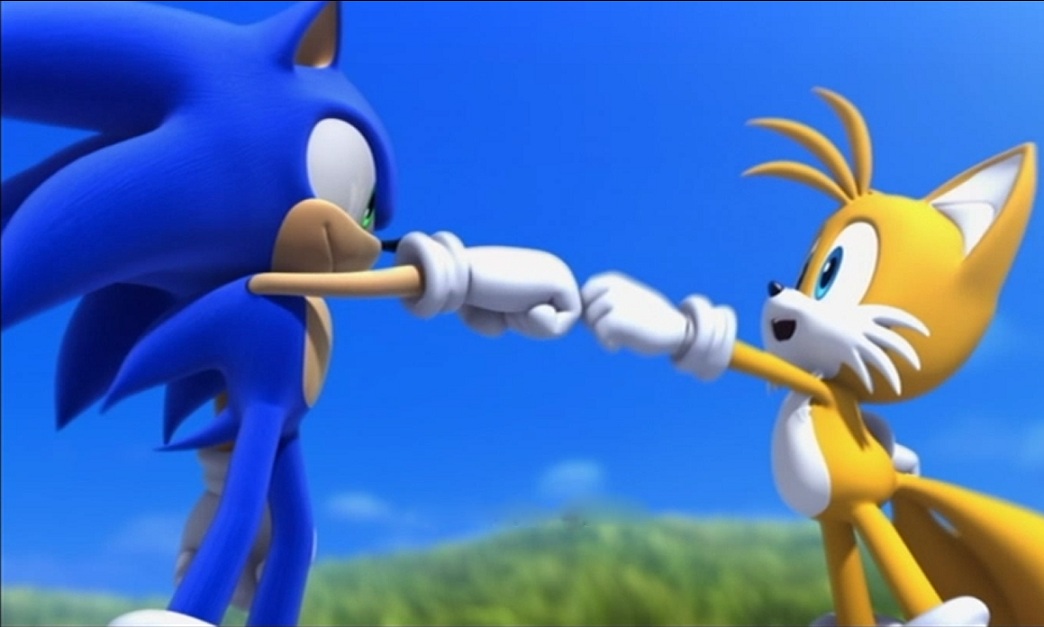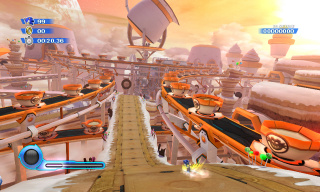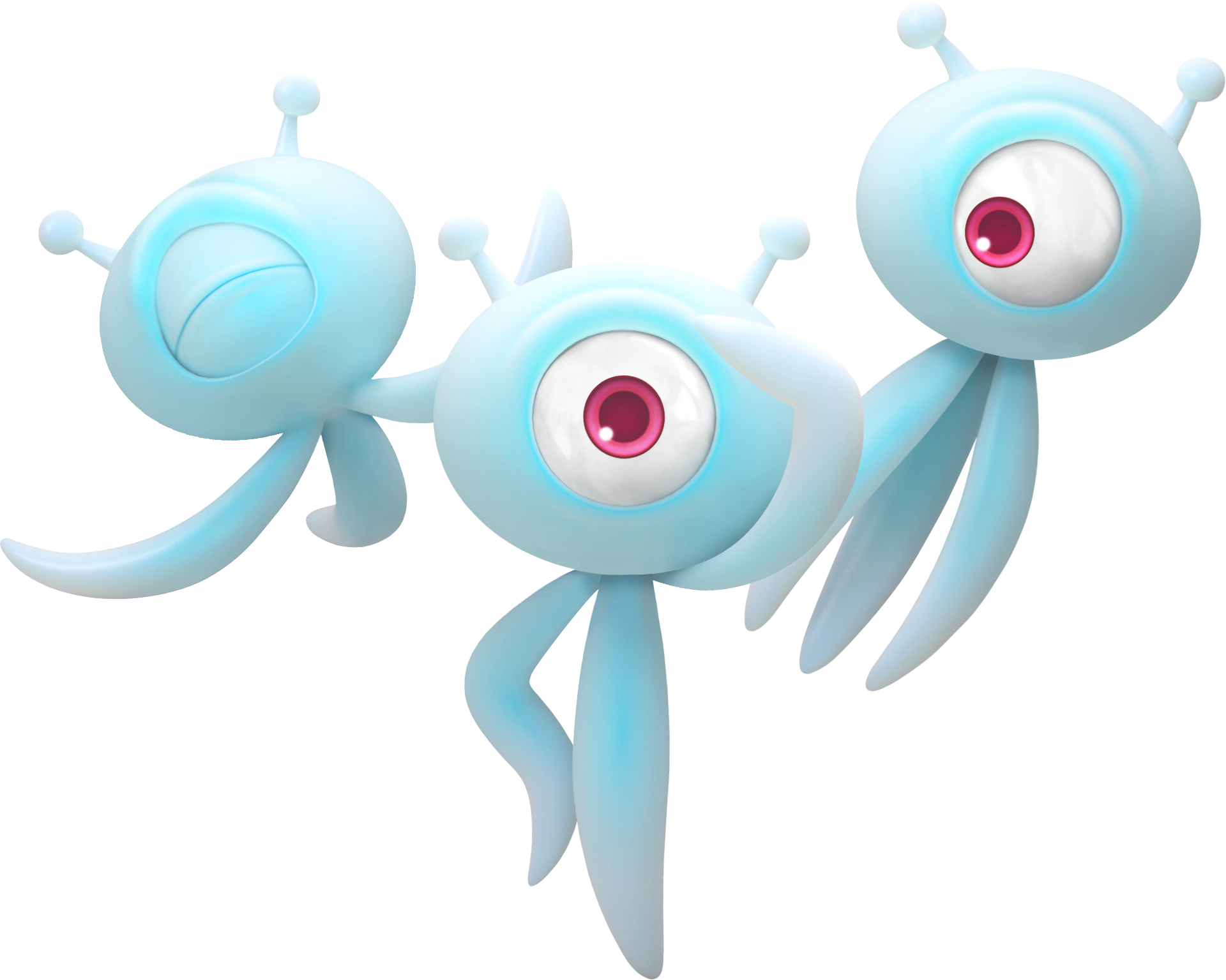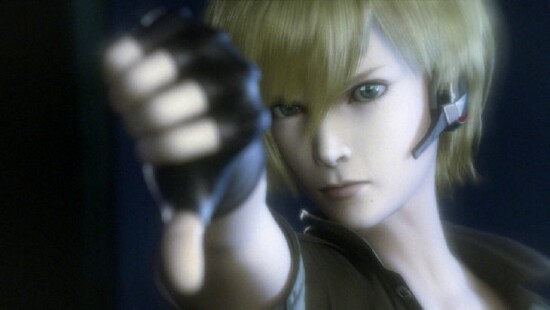Hey, guys?
Sonic.
In the not-so-distant days of my early teenhood, I would
spend hours almost weekly with my copy of Sonic Unleashed, tearing through the
same levels over and over again as if it were some sort of platforming messiah.
For all of the other, better games I could have been spending my time with,
Sonic Unleashed ate up unreasonable amounts of it. Looking back at it, for all
of the problems that made it such a bittersweet experience, I can still see how
it left me so entranced. There are many who would argue that even the good half of the game was just mindless
garbage with sloppy controls, but Lord, was it fun. The combination of thrilling speed, reaction-based obstacles,
an excellent sense of atmosphere, gorgeous visuals and blood-pumping music
managed to sell it so well despite how automated it might have been. Playing it
was almost therapeutic, relaxing in a way, and it gave me a glimpse of a
brighter future for a series that seemed to have lost all hope. With such a
solid base, everything seemed so easy to fix if you got rid of all the awful
fluff that surrounded it. With more polish and more intricate level designs,
you could turn this into something absolutely fantastic. Finally, the dream
came true, as 2011’s Sonic Generations saw this gameplay fully refined into the
awesome blend of thrilling speed, solid platforming and awesome exploration that
made the Genesis classics…ehm…classics, all
in a 3-D environment. Unleashed was style over substance. Generations said…
But now, that era has passed, and it’s time to break new
ground. Thus was announced Sonic Lost World, for the Wii U and 3DS. And holy crap, wow, I have never been so
immediately blown away by a Sonic game since…eh, since Generations, so it
hasn’t been that long. BUT, that notwithstanding, it looks like it could bring
a massive evolutionary leap to the series, and a well-earned one now that it’s
regained its stride. The innovative style of level design lends itself to so many creative possibilities, and
what’s been shown is already very cool.
The levels are already promised to have tons of exploration, and for Sonic,
that’s always great. The proposed refinements to Sonic’s controls could
seriously improve the experience, as well, and...the parkour. The freaking parkour. It just sends fanboy shivers up my spine to see
something this innovative, this bold
to come out of the series. But one of the more curious elements to the game is
the return of the central mechanic of 2010’s Sonic Colors, the Wisps.
i literally just put in the first Lost World video that came up
Ah, yes, Sonic Colors. In the midst of all this, it seems
that the game that was perhaps most crucial in rebuilding Sonic’s reputation
has almost drifted out of the public consciousness. Sonic Colors was downright revered when it came out for Wii that
year, heralded as the game that would finally end the so-called “dark ages”.
Being the first main console Sonic game in years to receive legitimate critical
praise, it really seemed like, yes, this was the one. The funniest part is that it came completely out of left
field. When it was first announced with a simple little trailer, no one expected that it would amount to
anything. It was a lower budget title developed by the same team as the “Sonic
Storybook Series”, and…well, those game were not that great, to say the least. Some laughably off-the-mark news reports from fan-based sources, which
stated that this would be a game made specifically to cater to young children
and no one else, didn’t help matters,
either. Meanwhile, everyone was waiting with baited breath for the 2-D return
to form that would surely get rid of all the franchise’s troubles and rescue
it from the ever-growing dung heap it into which it had sunk. Eh, yeah, we all
kinda know how that turned out.
But then, E3 came and along with it, gameplay footage. And…that
was it. Suddenly, this was the next
big game. It looked like the fabled “Unleashed minus the Werehog” that so many
had wanted, and the game’s new gimmick actually looked…fun. And when it finally came out, it was proclaimed the best 3-D
Sonic game since 2001, if not the best of all time. The fandom rejoiced,
critics announced that Sonic was back, and I was a happy, happy boy. But then, once Generations came out, the
public just…forgot Colors existed. Okay, well, maybe they didn't "forget" it, but I don't see this game being acknowledged as much as it should be. Yes, many will still dwell on past failures
like Sonic 06 and the Werehog, perhaps giving a passing mention to Generations
while still prefacing each piece of gaming journalism with some variation on
the phrase “Sonic has sucked for a very long time.” On one hand, I don’t mean
to say that Colors is somehow objectively amazing or anything, but on the
other…this is a pretty significant game to be forgetting when many critics
themselves conceded that it was, indeed, good. But not only is it a landmark in
the series’ history, being the first game in years that was actually legitimately great; it’s also an
excellent piece of Sonicy, platforming goodness that’s still well worth
anyone’s time. Let’s take a closer look at exactly how this game turned out to be the series’ fabled savior, and why
you should still play it.
In the story of Sonic Colors, Dr. Eggrobomanik has chained
together several planets in order to create Eggman’s Interstellar Amusement
Park, a supposed apology for his past transgressions. Sonic and Tails are
unconvinced and decide to pay the place a visit. Not long after arriving, they
find that Eggman is capturing local aliens known as the Wisps and harvesting
their Hyper-go-on energy to power a mass mind control weapon that’s being
concealed by the park. Sonic and Tails must
now stop him and…that’s…it. No horrifying eldritch abomination as a final
boss. No annoying fairies fluttering around Sonic’s head trying to act “cute”.
No time-traveling recolors. No senselessly dark twists. Just Sonic and Tails
foiling Eggman’s plot for the hundredth time. “It’s like it’s our job or
something,” comments the blue blur, and that, it most certainly is. It’s
basically the plot of a classic Sonic game applied to a modern one. The
charming simplicity of this story was very
refreshing at the time, but the end result is a lot of fun even now, thanks in
no small part to the then-new writers. Up
until the surprisingly big climax, the whole thing carries itself
with a laid-back and lighthearted tone comparable to a Saturday morning cartoon,
and we spend most of the story watching Sonic and Tails interact. There’s really
just something inherently endearing about watching the two goof around like the
good friends they are, which owes itself to the excellent characterization.
After Sonic Adventure 2, pretty much every character
devolved into a horrific, unlikable flanderization of their personality
archetypes thanks to the crippling hand of absolute writing failure. In this
game, Sonic and Tails talk and behave like actual, legitimate, multi-faceted characters. Sonic isn’t just a boring,
heart-of-gold hero-person who loves to run and stuff. He’s cocky, he’s
arrogant, he likes to gloat and be a wiseacre. You know, kinda like how he was before he was drained of all personality.
Tails, on the other hand, rather than being a boring genius sidekick, is
actually Sonic’s friend. He’s still
obsessed with mechanics and technological stuff, but he has a bit of a sense of
humor now and likes to joke around with his good buddy. Oho, and Eggman, of
course, is just perfect. It’s not
just in the story, either; his PA announcements play throughout all of the
levels, commenting on various things pertaining to the park in a humorously dark,
sarcastic manner. It’s just gold.
Of course, stellar characterization is best delivered with stellar
voice acting, something the series is known specifically for not having. But, Colors introduces new
voice actors for Sonic and Tails, and they do so well. Roger’s voice may not fit the character as well as
Drummond, but as an actor, he blows any
previous portrayals completely out of
the water. For once, the character actually sounds believable. Kate Higgins also does an excellent job as Tails and
Mike Pollock, the one really good actor out of the previous bunch, is still an
absolutely fantastic Eggman. When it comes to the script itself, the game has
received both praise and criticism for its cartoony sense of humor, which takes
a lot of prominence in this entry. Some people find it charming and others find
it groan-inducing. Personally, I think it’s just a bit hit or miss. I could really do without jokes about “underwear
being worn by salad” or…uh…Eggman’s burps, but there are some chuckle-worthy moments
in there. Some of it admittedly devolves into late-2000’s Dreamworks-level
“annoying equals comedy” humor, mostly with the designated comic relief
characters named Orbot and Cubot. Yeah, the joke involving Cubot getting
mixed-up voice chips was “cute” at first, but it got old really quickly. Still, thanks to strong characterization and
character interaction, the writing is surprisingly good overall and makes this
very simple storyline a very fun one to watch.
Gorgeous visuals are a hallmark of the series, and Colors
is…howhoa. Colors offers some of the
greatest visual creativity you will find in the entire series, comparable only
to the likes of Sonic CD. You’d expect a game called Sonic “Colors” to be
pretty colorful, and yeah, it gives you a lot of colorful things to look at.
But that’s not the only thing impressive about it. The art design for every location in the game is stunningly inspired. It takes the abstract ridiculousness of the
classics up to 11 while at the same time making every location feel
deliberately structured for some purpose. The amusement park theme remains
consistent, but isn’t a hindrance in providing some of the most original and
even quirky level ideas the series has seen yet. The soundtrack, similarly, is
one of the absolute best you’ll hear in the series, and each track compliments
every level’s atmosphere brilliantly.
Take Sweet Mountain, for example. Worlds made entirely out of candy and other
such confections are nothing new for the platforming genre. However, Sonic’s
first take on “Level Ate” is awesomely ridiculous when you realize that it’s not just a planet inexplicably made up
of food, but was built to be one.
(insert painfully obvious joke about Eggman’s weight here) Despite all the
massive food items that make up the very ground you stand on, the whole thing
has a very industrial feel to it. This is reflected in the level’s soundtrack,
full of blaring horns and loud drums alongside an upbeat guitar.
Speaking of industrial, Planet Wisp is another level with a very interesting atmosphere. It’s the planet from which the Wisps hail, and
as Eggman has started using them for his evil purposes, so too has he begun to
convert the planet into another part of his ever-growing amusement park. The
result is a beautifully surreal landscape slowly being overtaken by Eggman’s
ugly technology. Gigantic industrial equipment is littered everywhere, and most
of the level takes place on metal scaffolding and glowing platforms that
heavily clash with the natural environment. Eggman’s dirty work can also be
seen through the massive lakes of chemical sludge pooling in the level’s lower
areas. The music’s instrumentation evokes something hauntingly beautiful, but
the composition gives a feeling of harsh urgency. There’s an ugliness
underneath all the beauty, and the way this level uses aesthetics to reflect
the circumstances of the story is something that seriously hearkens back to the classics. But those are only two of
those games six worlds. I could go on and on about the bustling atmosphere of
Tropical Resort, the utter whimsy of Starlight Carnival, the fantastic aquatic
feel of Aquarium Park, or the awesome extremeness of Asteroid Coaster, but
that’d take up an unreasonable chunk of the review. Of course, on the subject
of the music, it doesn’t just compliment the visuals, but the gameplay as well.
Faster-paced levels with bigger setpieces are frequently accompanied by
appropriate compositions, while slower, more laid-back remixes accompany the
more platform-based ones.
Which gives us a smooth transition to the part where I talk
about the gameplay, and believe me, it is good.
The vast majority of 3-D Sonic games from Sonic Adventure up to Unleashed used
some form of alternate gameplay to spice things up a bit, most notably in
Unleashed with the…egh…Werehog. Yeah,
there were times when it worked better than others. Colors, on the other hand,
sticks to a single gameplay style throughout: a tweaked version of the fast,
boosting-based gameplay with constant switching between 2-D and 3-D
perspectives that defined Unleashed’s better half, with a heavy focus on a new
power-up gimmick. The game is much better off for it not only because it avoids
problems of inconsistency that plagued some earlier titles, but also because it
allows Colors’ gameplay to be developed to its full potential. One thing many
noticed at the time, coming straight off of Unleashed, was that Unleashed’s
more speed-based play style was traded in for a more platforming-based one. Sonic’s trademark speed is still very much
here, but big setpieces and fast moments are often broken up by moments of
slower-paced platforming. This was later worked into the speedier stuff through
2011’s Generations, but Colors’ focus on platforming is nonetheless a very
welcome one that contributes to its aversion of Unleashed’s arguable
mindlessness. That said, some would complain that the platforming is a bit too
simplistic. It’s certainly true that Colors has a buttload of “block
platforming”, but personally, I think Colors executes it pretty well if only because
of how well put-together it is. The platforming does start out quite basic in early levels, but the designs grow
more fun and interesting as you go on. And while it doesn’t have that sense of
constant innovation or mind-blowing originality you might find in a typical
Mario platformer or, say, Donkey Kong Country Returns, the diversity present in
Colors’ levels doesn’t fail to please.
Each world in the game is separated into six Acts. Some of
them are filler, but most of them do offer something fun. Of course, the worlds
do have their inherent differences from each other. Tropical Resort is
generally the most generic, being the first level. Sweet Mountain offers
surprisingly few sweets-based gimmicks in regards to gameplay, but gives enough
clever platforming to make up for it. Starlight Carnival is where you’ll find
some of the game’s most automated segments, but the sheer spectacle of it all makes
it fun nonetheless. Planet Wisp has a lot of rail-grinding and some more
complex platforming designs, while Aquatic Park is a water level with an
excellent sense of scale and much to explore. And Asteroid Coaster, naturally,
has a lot of rollercoasters in it as
well as some more unique platforming ideas, such as gravity switching and
platforms that slowly move in and out of walls. Taking a look more at the
individual levels, however, the game still finds a lot of ways to keep the gameplay
feeling fresh. Sweet Mountain 4 has some unique button-based mechanisms that
require you to wait for the right moment to proceed, giving it a nice ebb and
flow for skilled players. Sweet Mountain 5, on the other hand, has somewhat
momentum-based lollipop swings that you have to use to progress at certain
points. Starlight Carnival 3 is an auto-scrolling level that introduces a
moving yellow spring that you have to stay on in order to make it through,
while Act 5 ends with a segment in which you climb a giant tower in 3-D. In
Planet Wisp 4, you’re actually running through a level that wraps around an
industrial tower to get to the goal, while Act 5 has Egg Pawns destroying the
very platforms you have to run on to proceed.
Those are just a few examples, and while the game does
recycle elements of its own design at points, the way each Act is constructed
usually differs enough to make each one feel adequately new. But by far, the
biggest factor in giving a sense of variety to Colors is its primary gimmick:
the Wisps. Yes, while the use of gimmickry in Sonic games is often derided, the
one Colors gives us to play with is a hugely positive addition that compliments
what’s there rather than taking away from it. The way it works is simple: as
you go through the levels you will find a Wisp of a certain color trapped in a
capsule. By walking into the capsule, you’ll open it and the Wisp will fly into
Sonic, giving him its power, which you can use at any time just by shaking the
Wii Remote. Some are timed while others are one-use-only. What’s really
impressive is that their integration feels so seamless – it hardly slows the
game down at all and using them just
becomes second nature. These Wisps could easily have been broken or overused,
but while some levels use them more than others, they never feel the least bit
intrusive. Wisp sections are balanced out really well with straight-up Sonic
platforming, and when the Wisps do come into play, it always works. There’s a
great variety of Wisps powers, all equally inventive both in their functions
and in the way the affect the game’s design.
You’ve got the CYAN LASER, which you aim to blast Sonic in
the direction you’re aiming, often used to traverse great distances or ricochet
from wall to wall. There’s the YELLOW DRILL, which allows you to traverse
underground areas to find new paths and secrets or easily travel underwater.
There’s also the PINK SPIKES, which gives Sonic the ability to cling to and
travel along any surface while also
allowing him to use the signature Spin Dash and plow through certain crates.
We’ve got the GREEN HOVER, allowing you to float gracefully through the air as
well as perform the Light Dash from previous 3-D outings. And then there’s
ORANGE ROCKET, propelling you to massive heights before gently skydiving
downwards when the sequence is over. The BLUE CUBE is a unique one that does a
ground pound move, not only eliminating any on-screen enemies, but also causing
a special kind of blue block to alternate between collectable Rings and vice
versa, leading to some of the game’s most fun and creative platforming
sections. My personal favorite, however, would have to be PURPLE FRENZY,
turning Sonic into a giant set of chomping teeth that eats up everything in its
path. The amount of originality used in
designing these power-ups is impressive enough, and it makes me happy to say
that the layouts built for them are every bit as fun. While it’s true that each
Wisp has only one real application, the way the levels are built around that
ability never fails to impress or to entertain. It’s in this way that Colors
brought a lot of creativity to the series without tripping over its own
ambition. And while ambition is certainly great – Lost World seems to have a
lot of it – sometimes, I think it can serve a game better just to play it safe.
Oh, but did I mention the amount of exploration this leads to? Yes, thanks to the Wisps, this game
offers a lot of possibilities when it
comes to exploring the levels, and many of them do have quite a bit to explore.
Encouraging this are the Red Rings, which unlock extra Sonic Simulator stages,
which, in turn, give you Chaos Emeralds, which, in turn, give you the ability
to play as Super Sonic. Yeah, it’s pretty neat, but that aside, many
of the level layouts tend to be quite complex, which is the main reason why I
feel that the “block platforming” works for this game. The platforming is
generally simpler to make for more complex setups utilizing the Wisps, and
personally, I think it’s great. However…this is where the game’s faults come
into play.
 |
| Oh yeah, white Wisps fill your boost meter instead of Rings in this game. Kinda forgot to mention that. |
Sonic Colors is an awesome game, but three years removed
from the hype, it’s easier to look at it a bit more critically and see some flaws.
When I first reviewed Colors only a few months after it came out, I gave
passing mention to some minor faults and concluded by giving the game a 9/10.
My view on the game hasn’t grown any less positive, make no mistake about that,
but there are some things about it I’ve grown less fond of. Mostly…it’s a bit
sad to say that what was, at the time, probably the best 3-D Sonic game to
date…doesn’t have much 3-D gameplay at all. Only about 20 or 30% of your time
spent playing the game is spent in 3-D, and honestly, the 3-D sections that are there, for the most part, really aren’t that great. Most of them
are pretty restrictive and bland, offering little of the actual platforming or
exploration you’d find in the game’s 2-D areas. The absolute worst ones reek
even more of “hold forward to win” than Unleashed, and while quick-stepping
segments usually fare a bit better, they still lack the intensity and thrill
that make Unleashed’s and Generation’s takes on them fun. Control, sadly
enough, is a bit sloppier in these segments as well. This isn’t to say there aren’t any good ones
to be found; Starlight Carnival 5 has a really cool one and Asteroid Coaster
has some unique homing attack sections. But the unfortunate truth is that, in
Colors, these sections usually work best when their main purpose is to show off
a really cool setpiece. Generations thoroughly fixed this, but it’s a pretty
big fault on Colors’ part.
And when it comes to the 2-D level designs, they’re great, don’t get me wrong, but…in many
cases, the level design feels almost disconnected
from the world it’s in, like the game isn’t using all of its tropes very
effectively. Tropical Resort, Aquarium Park and Asteroid Coaster use their
ideas well, but when I look at Sweet Mountain, Planet Wisp and, in some ways,
even Starlight Carnival, I just feel like there’s a bit of missed potential
here. You see all of this cool, amazing stuff in the background that could have
made for some awesome levels on their own, but the parts you actually get to
play through, with some big exceptions, don’t feel like they have all that much
to do with what you’re seeing. Again,
the levels are still great, but more could have been done with the ideas here.
The only other problem is the bosses. There are two big issues that plague the game’s boss
design: easiness and rehashing. Even the ones that are quite fun, such as Sweet
Mountain’s boss or Asteroid Coaster’s, tend to lack an honest challenge. What’s
pretty ridiculous is that the game actually recycles the first three bosses for
the last three worlds, and while Asteroid Coaster’s boss is certainly an
improvement over Starlight Carnival’s, Planet Wisp’s might as well be the same
as Tropical Resort’s and Aquatic Park’s turns Sweet Mountain’s otherwise decent
boss into something quite unfun and awkward. Aside from that, it generally
feels really lazy. Fortunately, though, the final boss is really awesome and
thus kind of makes up for the preceding bosses’ lameness.
But while its flaws may not be as easy to overlook now that
the “holy crap it’s a new Sonic game and it’s good” feeling has worn off, Sonic
Colors still really holds up.
Generations may have improved upon its core, but Colors is still a pretty dang unique
Sonic game that’s a lot of fun in its own way. It’s pretty
short, but there’s some really good
replay value here. This is game with a lot of creativity and heart, and it
desperately wants to find a place in yours. My advice is to give it a go and
see if you can let it in. If nothing else, you’ll have fun just seeing what it
has to offer. While Lost World is bringing enough innovation to the table already,
I am very glad that it’s bringing the
Wisp powers back, and I can’t wait to see how it expands upon them. They’re a big part of what makes Colors what
it is, so it’ll be fun to see what they can add to the new entry. Perhaps some still don't want to shut up about all the Sonic games that sucked, but personally, I prefer to focus on the recent games that don't. I'm seriously hyped for Sonic Lost World not as the game that will redeem the series, but as yet another high-quality title in an ever-flowing stream.
 |
| Oh, but also, it has more Level Ate. EEEE~ |
Oh, forgot one thing, though.
Stay away from the DS version of Colors.
It's poop.

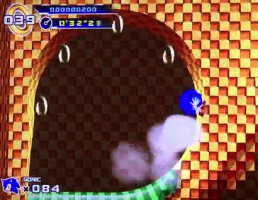
_(NA).jpg)
